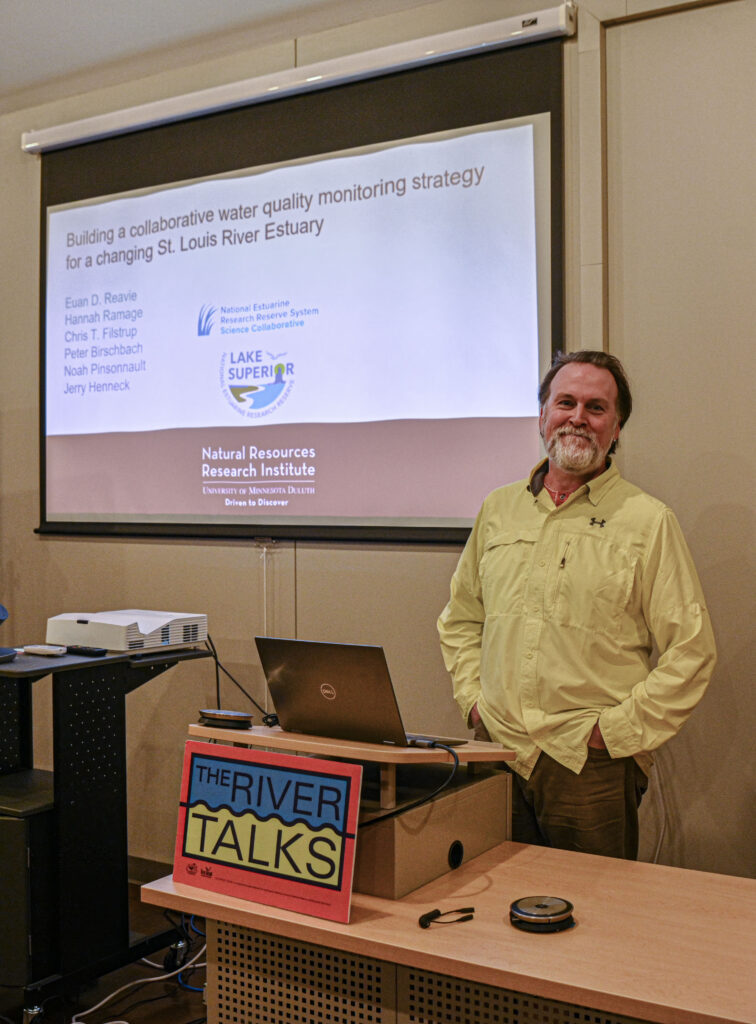Understanding harmful algal blooms in the St. Louis River Estuary presents challenges

Euan Reavie presents at River Talks. Image credit: Michael Anderson
Harmful algal blooms are becoming more of a concern in the St. Louis River Estuary and Lake Superior. The reasons behind this were described during the November River Talk by Euan Reavie, senior research associate at the University of Minnesota’s Natural Resources Research Institute.
Harmful algal blooms, also known as HABs, appear as mats of bright green algae that float on the surface of the water or sometimes lay on the bottoms of large rivers or lakes. Not all algal blooms are toxic, but some are, and scientists are looking into what triggers the release of toxins in the blooms.
“Based on anecdotal and real observations, it does seem to be something that’s getting worse in Western Lake Superior,” Reavie said. “Whoever thought we’d be getting algal blooms out in the nutrient-poor waters of Lake Superior, making their way all the way up to the Apostle Islands?”
Water quality in the St. Louis River has improved over the years thanks to sanitary sewer districts coming online in Duluth and Superior in the 1970s, environmental regulations, and cleanup efforts. However, excess nutrients such as phosphorus and nitrogen are still of concern and are a focus of attention from management agencies.
Reavie’s research team came into the picture in the early 2010s when they were asked to research nutrient levels in hopes of confirming that they were decreasing. They collected sediment samples (cores) to reconstruct the history of nutrients in the estuary. The scientists analyzed the samples for different types of fossil algae, which offer signals about what types of nutrients were available in the past because different algae species prefer different levels of nutrients.
Diatoms are the most abundant type of algae in the Western Lake Superior system. Reavie showed how the assemblages of these species changed after European settlement and after water cleanup efforts in the 1970s.
Over the past several years, algae blooms have been noted along the shore of Lake Superior near Cornucopia, Wisconsin, and in the estuary at Barker’s Island and Allouez Bay. Reavie said that sediment samples from the present day in sheltered bays like Allouez Bay show diatom species that like high levels of nutrients. He said the data show a “fairly consistent” increase in phosphorus in the system. “Not good news for the bays in the estuary,” he said.
The team also found cyanopigments in the samples, which indicate recent increases in algae. “There appear to be some new problems in these nearshore areas despite the fact that we’ve reduced the flux of nutrients into the system. Something new is going on here,” Reavie said.
One culprit could be more intense storms due to climate change. Storms wash a lot of nutrients from the land into the water and then the currents carry them through the estuary and harbor, and out into Lake Superior along its South Shore.
“Just knowing that the blooms tend to follow storms is not enough. There’s probably a seasonal aspect to all this, as well,” he said. Warmth is one factor, but Reavie said there have also been algae blooms under the ice. Low dissolved oxygen levels in water could be another factor, resulting in a chemical reaction that releases stored nutrients in sediments.
His team has begun developing an early warning system to sort out what is going on. It involves incorporating weather data, water quality data and algae data from eight stations in the estuary. They hope to offer initial findings at the March 2024 St. Louis River Summit.
For more information, visit the team’s website.
The next River Talk is scheduled for March 13, 2024. Brandon Krumwide with the National Oceanic and Atmospheric Administration will present, “What Lies Below? Underwater Mapping of the Great Lakes,” at 6:30 p.m. in the Lake Superior Estuarium (3 Marina Drive, Superior, Wisconsin).
The post Understanding harmful algal blooms in the St. Louis River Estuary presents challenges first appeared on Wisconsin Sea Grant.Blog | Wisconsin Sea Grant
https://www.seagrant.wisc.edu/blog/understanding-harmful-algal-blooms-in-the-st-louis-river-estuary-presents-challenges/

